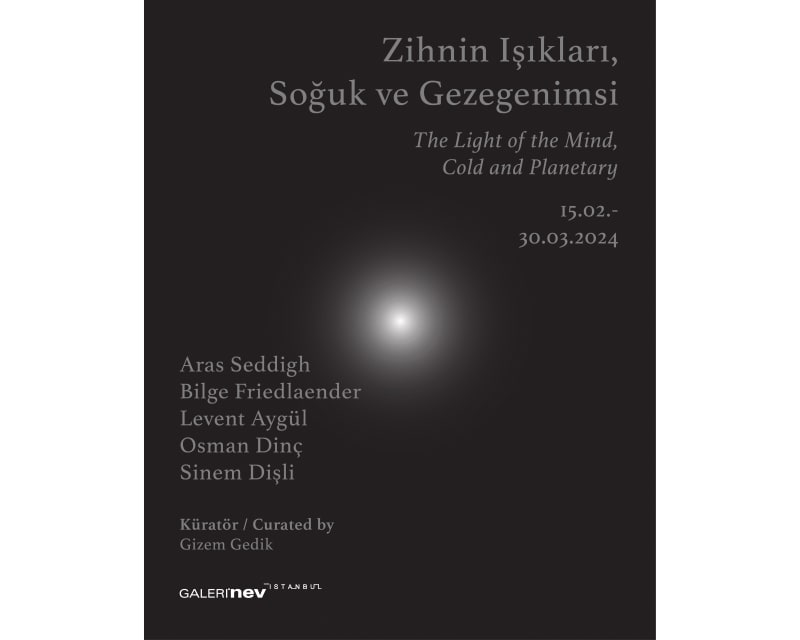The Light of the Mind,
Cold and Planetary
15.02 – 30.03.2024
Bringing together works by Aras Seddigh, Bilge Friedlaender, Levent Aygül, Osman Dinç and Sinem Dişli, the group show titled The Light of the Mind, Cold and Planetary takes place at Galeri Nev İstanbul between February 15 – March 30, 2024, curated by Gizem Gedik. Taking its title from the lines of Sylvia Plath's poem The Moon and the Yew Tree, the exhibition treats the image of the moon, which has always played a central role in the history of humanity and culture, as a metaphor and a commonality of expression that could be read in connection with various concepts. Associated with the light and dark inner world of the individual, with death and depression, with feminine energy and the phases of change in the context established between nature and human, the moon symbol in the exhibition opens up to the idea of a centre-periphery through its relationship with the Sun, to its connections with the mind and knowledge through its reflection and reflectivity, and to the ideas of ritual and cycle through traditions and symbols passed down from generation to generation. Despite being considered a satellite planet according to geophysics, the moon's reflective properties and enigmatic presence continue to evoke a myriad of psychological and social connotations. From melancholy to passion, birth to death, the moon's cold light and nocturnal loneliness inspire diverse interpretations and readings.
---
"This is the light of the mind, cold and planetary. The mind's trees are black, its light blue."[1] Sylvia Plath's poem The Moon and the Yew Tree, written only two years before her suicide, opens with these lines. This ambiguous poem, which confronts us with an eerie yet alluring melancholy, unfolds as the lines progress, revealing the poet's association of the moon with her mother's distant and strict nature. However, apart from Plath's family relationships and severe depression, it is also possible to find various associations hidden within the lines, making different readings about nature itself and the nature of human beings, or about faith and despair. But is the moon, with its cold light and nocturnal loneliness, only an image that evokes melancholy and sadness? How can a display incorporate different perspectives on what this form suggests and evokes in us? Moreover, this profound image, which inspired sonatas, poems, and tales, has surprisingly come to symbolize birth and death, passionate love, and solitude at the same time. Exactly eight years after Plath's poem, it embarked on a new journey of meaning as humanity planted its flag upon its surface, reshaping its very myth. Once, the world's ambition laid in exploring and conquering continents, but then, it turned its gaze towards the Moon. Setting foot upon it had become the ultimate ambition, marking a new era of exploration and conquest. With this development, which led some to fear that the Moon would no longer be a source of romantic inspiration, but merely an object of scientific study, a barren and lifeless body, it became the object of the myth of American pioneering, proving that the nation stood as the world's superpower. But despite all this, it has never lost its romantic, mesmerizing and atmospheric effect. This cold, dark grey, stone-like / planetary / luminous structure, although it cannot be fully placed in definitions, continues to be reborn and disappear every month in its own way, to affect human nature in its various phases and to relate to different concepts.
From Rûmî and Şems-i Tebrîzî's story of love and knowledge to Lars Von Trier's Melancholia, from the Canadian town of Banff to the symbolic rituals of Göbeklitepe, from avant-garde revolutionaries' ideals of illuminating the darkness with knowledge to myths and clichés, the exhibition follows the path of minimal, repetitive gestures, humble and simple images while reaching from geological facts to deep metaphors.
Galeri Nev İstanbul can be visited from Tuesday to Friday between 11 pm – 6.30 pm and on Saturday from 12 pm – 6.30 pm.
For more details and questions: info@galerinevistanbul.com
[1] Sylvia Plath, Ariel by Sylvia Plath – Poems Selected by Ted Hughes, Faber and Faber Limited (London, 1985)
“The Moon and the Yew Tree” (1961)

